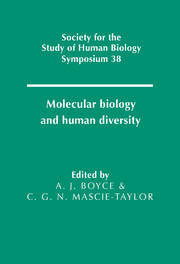Book contents
- Frontmatter
- Contents
- List of contributors
- Preface
- 1 Mitochondrial DNA in ancient and modern humans
- 2 Digital DNA typing of human paternal lineages
- 3 Minisatellites as tools for population genetic analysis
- 4 DNA fingerprinting: development of a technology and its application to the study of human populations
- 5 Kinship, inbreeding, and matching probabilities
- 6 Using the coalescent to interpret gene trees
- 7 Some attempts at measuring natural selection by malaria
- 8 AIDA: Geographical patterns of DNA diversity investigated by autocorrelation statistics
- 9 Mitochondrial DNA sequences in Europe: an insight into population history
- 10 Palaeolithic and neolithic contributions to the European mitochondrial gene pool
- 11 The molecular diversity of the Niokholo Mandenkalu from Eastern Senegal: an insight into West Africa genetic history
- 12 The peopling of Madagascar
- 13 Molecular perspectives on the colonisation of the Pacific
- 14 Population ancestry on Tristan da Cunha–the evidence of the individual
- 15 Linguistic divergence and genetic evolution: a molecular perspective from the New World
- 16 Allelic sequence diversity at the human β-globin locus
- 17 A nuclear perspective on human evolution
- 18 Contrasting gene trees and population trees of the evolution of modern humans
- 19 Methods and models for understanding human diversity
- Index
1 - Mitochondrial DNA in ancient and modern humans
Published online by Cambridge University Press: 19 September 2009
- Frontmatter
- Contents
- List of contributors
- Preface
- 1 Mitochondrial DNA in ancient and modern humans
- 2 Digital DNA typing of human paternal lineages
- 3 Minisatellites as tools for population genetic analysis
- 4 DNA fingerprinting: development of a technology and its application to the study of human populations
- 5 Kinship, inbreeding, and matching probabilities
- 6 Using the coalescent to interpret gene trees
- 7 Some attempts at measuring natural selection by malaria
- 8 AIDA: Geographical patterns of DNA diversity investigated by autocorrelation statistics
- 9 Mitochondrial DNA sequences in Europe: an insight into population history
- 10 Palaeolithic and neolithic contributions to the European mitochondrial gene pool
- 11 The molecular diversity of the Niokholo Mandenkalu from Eastern Senegal: an insight into West Africa genetic history
- 12 The peopling of Madagascar
- 13 Molecular perspectives on the colonisation of the Pacific
- 14 Population ancestry on Tristan da Cunha–the evidence of the individual
- 15 Linguistic divergence and genetic evolution: a molecular perspective from the New World
- 16 Allelic sequence diversity at the human β-globin locus
- 17 A nuclear perspective on human evolution
- 18 Contrasting gene trees and population trees of the evolution of modern humans
- 19 Methods and models for understanding human diversity
- Index
Summary
Introduction
The study of the patterns of genetic diversity in modern human populations can help reconstruct human evolutionary history, including ancient migrations, population expansions, and bottlenecks. However, the interpretation of early events based on modern genetic patterns may easily be obscured by more recent developments, for instance, multiple migrations, invasions, or demographic collapse resulting from infectious diseases or genocide. Additional information in the form of linguistic analyses, historical reports or the archaeological record can be used to build some kind of approximate picture of our past. Moreover, the development of powerful techniques for DNA analysis, notably the polymerase chain reaction, enables us to gain direct genetic information about past peoples in the form of DNA amplified from bones or mummified soft tissues.
In recent years, mitochondrial DNA (mtDNA) has achieved a prominent place in the study of human evolutionary history because it is simple, easy to study and evolves quickly. The human mtDNA genome is a closed circular molecule of approximately 16 569 base pairs in length (Anderson et al., 1981) located in the cellular cytoplasm. It contains only 37 genes, no introns, and little other non-coding DNA besides the 1 kb (kilobase) control region. The mtDNA genome is inherited in a maternal fashion, without recombination, and evolution occurs by the accumulation of mutations through time.
- Type
- Chapter
- Information
- Molecular Biology and Human Diversity , pp. 1 - 11Publisher: Cambridge University PressPrint publication year: 1996



